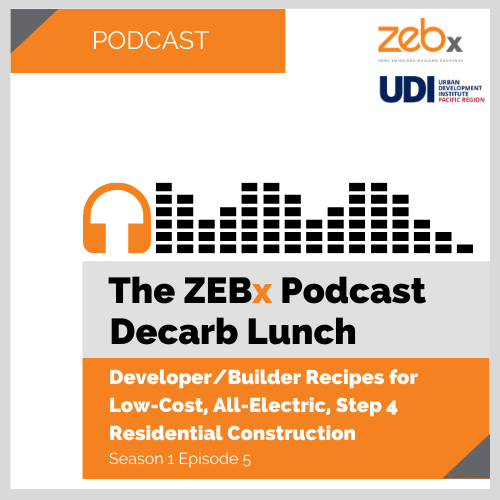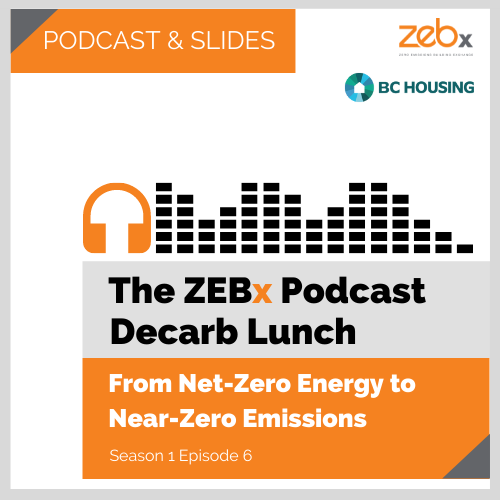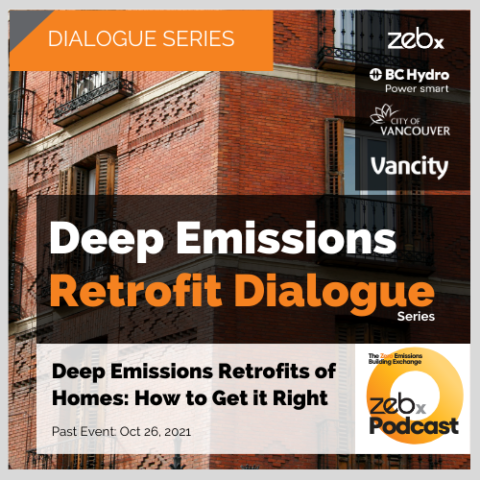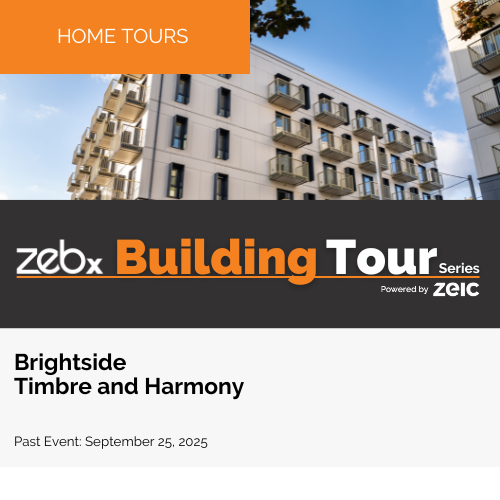
Jul 2021 Decarb Lunch Podcast: Developer/Builder Recipes for Low-Cost, All-Electric, Step 4 Residential Construction
October 5, 2021
Oct 2021 Decarb Lunch Podcast: From Net-Zero Energy to Near-Zero Emissions
October 29, 2021
Deep Emissions Retrofit Dialogue Two – Deep Emissions Retrofits of Homes: How to Get it Right
Recorded at Past Event: Oct 26, 2021
Slides:
This event was a collaboration with the Home Performance Stakeholders Council (HPSC).
Summary
The biggest source of future operational emissions from the building sector will come from existing, rather than new buildings. Retrofits which target massive reductions in operational emissions are essential to address the climate crisis and will need to be scaled up dramatically over the next decade. In British Columbia, electrification is the most effective strategy to achieve significant, immediate, and real emissions reductions.
This event was the second in a six-part series focused on deep emissions retrofits. The presenters shared best practices for reducing emissions from homes, from both a building-specific and local government perspective.
Lessons Learned in Decarbonizing a Personal Residence
Presented by Gary Hamer, BC Hydro
Gary’s situation was like that of many homeowners. His carbon footprint was predominantly the result of car travel, air travel, consumerism, food and using gas-fired appliances in his home. This awareness was a driving force in his goal to completely electrify his home. Through his technical expertise, methodical analysis and practical problem-solving, Gary was able to successfully complete his electrification project and make a major dent in his carbon footprint. His presentation provided a set of best practices for other homeowners to follow.
Barriers Presented:
- Determining whether the existing panelboard could handle the additional electrical load
- Determining the size of the heat pump
- Finding a reputable contractor with an experience installing heat pumps
- Evaluating other benefits (not related to emissions and energy) of electrification
Recommended Solutions:
- Engage an experienced energy advisor to evaluate the home’s energy performance.
- Ensure that a CSA F280-12 heat loss/gain analysis is performed to determine the correct capacity for the heat pump.
- Use an app like the HydroHome app to determine your electrical load profile, including peak load, of the last few years.
- Improve the energy performance of the home by adding insulation, replacing the windows and/or implementing other recommendations from the energy advisor’s report.
- Look for a heat pump installer with HPCN, TECA and/or HRAI certifications and/or training.
For more information on this home electrification project and some great tips if you’re considering something similar, read this B2E article.
Deep Emission Retrofits: Critical Mechanical Design Considerations
Presented by Rob Pope, Ecolighten Energy Solutions
To support the City of Vancouver in its development of a potential future home retrofit program, Ecolighten was engaged to assess the feasibility of HVAC retrofits in eight Vancouver homes with in-floor radiant heating. The study produced five key findings.
- Currently, consumers are not sufficiently supported when it comes to vetting contractor recommendations, evaluating cost estimates, understanding heat pumps and accessing rebates and other financial incentives.
- Although some mechanical contractors are familiar with air-to-air heat pumps, very few are familiar with air-to-water heat pumps required for in-floor radiant heating.
- Retrofits should focus on the envelope first and whole home solutions to ensure that heat pumps are properly sized and appropriately selected for retrofit applications.
- Without energy efficiency upgrades to the home, existing homes with 60 A or 100 A electrical service will likely require service upgrades that can vary in cost from $1,000 to $10,000.
- Additional space is required both inside and outside (for air-to-water heat pumps) and this may be challenging for homes with small yards, small mechanical closets and/or tight property setback conditions.
The presentation also included more detailed findings of one of the homes in the study. The owner was highly motivated to replace the gas boiler in his 2,400 square foot home, built in 1928, with an air-to-water heat pump. He had proceeded to collect quotes from three mechanical contractors, but the recommendations and quotes varied considerably.
Local Government Approaches to Enabling Home Retrofits in the Decade of Action
Presented by Maya Chorobik, Community Energy Association
CEA has identified decarbonization of existing buildings as a key priority for local government climate action plans and to support local governments, CEA has established a peer network focused on retrofits. Local governments and the Province play a critical role in scaling up retrofits through policies, regulations, programs, financing support, contractor support and implementing retrofits of municipal and provincially-owned buildings.
Deep energy retrofits (with GHG reductions in the 40 – 60% range) and electrification projects (with GHG reductions in the 80% to 100% range) should be supported by local governments. Reducing emissions through electrification is often less expensive than through energy conservation measures. In addition, because electrification is a very effective emissions-reduction strategy, fewer projects are required to achieve municipal or provincial goals. For example, a study for the City of Nelson showed that, to achieve a 50% reduction in emissions by 2030, approximately 500 homes/year required a deep energy retrofit. The same result could be achieved with only 180/homes/year if electrification was chosen as the decarbonization strategy. Due to the varying applicability of electrification for homes, both strategies will likely be required to meet serious emissions-reduction targets.
The presentation also provided recommendations to local and provincial governments, including specific recommendations for retrofit programs based on CEA’s Kootenay Clean Energy Transition pilot project and the Pumping Up Savings in Heat (PUSH) program.
Presenters
Gary R. Hamer, Residential Specialist Engineer, Advanced DSM Strategies, Conservation & Energy Management, BC Hydro
Gary’s role at BC Hydro is to advance energy savings and peak load reductions through codes and standards in the residential sector. Since joining BC Hydro in 2001, he has specialized in the efficient use of energy in residential housing. Gary’s standards work is done through the Canadian Standards Association (CSA) where he serves as Chair of Technical Committee (TC403) for the energy performance of residential equipment. These standards are used by governments to regulate minimum performance levels of equipment sold provincially or federally. Gary also serves as Lead for the CSA Working Group for Residential Part 9 Buildings which reports to the Technical Committee (TC424) on Building Energy Systems. He also serves as chair of the Development Committee for CSA EXP07 – A Load-based, Climate-specific Testing and Rating Procedure for Heat Pumps and Air Conditioners and on the steering committee for CSA EXP17 – Guidance on the Best Practices for Mechanical Systems.
Helping to advance residential construction codes, Gary is a member of the Canadian Home Builders’ Association (CHBA) Net Zero Energy Homes (NZEH) Council and serves as the chair of their technical committee which manages the NZEH labeling program requirements. Provincially, Gary serves on a BC Energy Step Code (ESC) task force to develop guidance on the best practices of the design, installation and verification of mechanical systems in new homes.
Rob Pope, Co-Founder/Senior Management, Ecolighten
Rob Pope is an HVAC design engineer with Ecolighten. He started working in the heating and cooling industry in the mid 1970`s where he began his apprenticeship in high-end custom homes, quickly earning tickets in sheet metal, refrigeration and gas fitting. During this time, he installed, serviced and began designing the first wave of energy-efficient systems such as condensing gas furnaces and boilers, heat recovery ventilation, heat pumps and solar thermal. Rob applied his skills in new home construction and existing home retrofits in southern Ontario, Alberta and British Columbia. Since the early 1990`s, he has been on the vanguard of heating and cooling technologies, including geothermal and variable refrigerant flow. As an active member of the industry, Rob has served as an executive member of the HVAC industry associations (HVCI & TECA), advocating for higher standards and better education for its members. He was the Mechanical Consultant on the first residence in Canada to achieve a Canadian LEED® certification.
Rob has been involved in the design and project oversight of many dozens of the most challenging and complex residential homes and estates in the industry, and continues to enjoy sharing his experience to achieve the best possible outcomes for everyone.
Maya Chorobik, Director of Climate Leadership, Community Energy Association (CEA)
Maya has been with CEA for 4 years, and before that worked in local government. Maya’s work spans many areas of CEA’s work, including supporting the development of climate and energy plans, facilitating peer networks and coaching for staff and elected officials, and working directly with local governments on policy and project implementation. Through coordinating the new Local Government Low Carbon Retrofit Peer Network, Maya is deeply engaged in thinking about how local governments can enable widespread deep energy retrofits across BC communities.
Hosts
Roberto Pecora, Director, ZEBx
Jovan Cheema, Managing Director of HPSC







